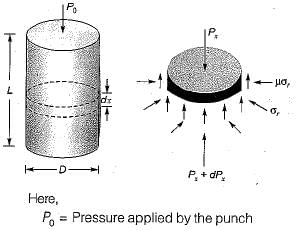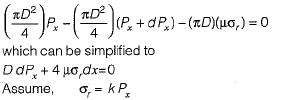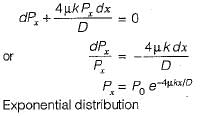Mechanical Engineering Exam > Mechanical Engineering Questions > Pressure distribution in powder compaction fo...
Start Learning for Free
Pressure distribution in powder compaction follows
- a)parabolic variation
- b)exponential variation
- c)hyperbolic variation
- d)linear variation
Correct answer is option 'B'. Can you explain this answer?
Verified Answer
Pressure distribution in powder compaction followsa)parabolic variatio...

D = Diameter of compact
Px = Compacting pressure
σr = die-wall pressure
μσr= Frictional stress along the die wall
K - Inter particle friction during compaction
Balancing the vertical forces acting on the element,

If there is no friction between the particles, k = 1,
the powder behaves like afluid, and thus
 signifying a state of hydrostatic pressure.
signifying a state of hydrostatic pressure.Now, we can have the expression,

Most Upvoted Answer
Pressure distribution in powder compaction followsa)parabolic variatio...
Pressure distribution in powder compaction follows exponential variation.
Explanation:
- Powder compaction is the process of compacting fine powders into a specific shape or form using pressure.
- During the compaction process, the pressure is applied to the powder from a punch or die, which causes the powder particles to rearrange and pack closer together, resulting in densification.
- The pressure distribution in powder compaction is not uniform, and it depends on various factors such as powder properties, die design, and compaction parameters.
- The pressure distribution can be determined by measuring the density distribution in the compact, which is related to the pressure distribution through the compaction equation.
- The compaction equation can be expressed as:
ρ = ρ0 (1 – ε)n
where ρ is the density of the compact, ρ0 is the initial density of the powder, ε is the strain, and n is the compaction coefficient.
- The compaction coefficient n is related to the pressure distribution, and it varies depending on the powder properties and compaction conditions.
- It has been observed that the pressure distribution in powder compaction follows an exponential variation, which means that the pressure decreases exponentially from the punch face to the die wall.
- The exponential pressure distribution can be expressed as:
P = P0 exp(-αx)
where P is the pressure at a distance x from the punch face, P0 is the maximum pressure at the punch face, and α is the pressure decay coefficient.
- The pressure decay coefficient α depends on the powder properties, die design, and compaction conditions. It can be determined experimentally or by numerical simulation.
- The exponential pressure distribution has been observed in various powder compaction processes, such as uniaxial compaction, cold isostatic pressing, and hot isostatic pressing.
Explanation:
- Powder compaction is the process of compacting fine powders into a specific shape or form using pressure.
- During the compaction process, the pressure is applied to the powder from a punch or die, which causes the powder particles to rearrange and pack closer together, resulting in densification.
- The pressure distribution in powder compaction is not uniform, and it depends on various factors such as powder properties, die design, and compaction parameters.
- The pressure distribution can be determined by measuring the density distribution in the compact, which is related to the pressure distribution through the compaction equation.
- The compaction equation can be expressed as:
ρ = ρ0 (1 – ε)n
where ρ is the density of the compact, ρ0 is the initial density of the powder, ε is the strain, and n is the compaction coefficient.
- The compaction coefficient n is related to the pressure distribution, and it varies depending on the powder properties and compaction conditions.
- It has been observed that the pressure distribution in powder compaction follows an exponential variation, which means that the pressure decreases exponentially from the punch face to the die wall.
- The exponential pressure distribution can be expressed as:
P = P0 exp(-αx)
where P is the pressure at a distance x from the punch face, P0 is the maximum pressure at the punch face, and α is the pressure decay coefficient.
- The pressure decay coefficient α depends on the powder properties, die design, and compaction conditions. It can be determined experimentally or by numerical simulation.
- The exponential pressure distribution has been observed in various powder compaction processes, such as uniaxial compaction, cold isostatic pressing, and hot isostatic pressing.

|
Explore Courses for Mechanical Engineering exam
|

|
Similar Mechanical Engineering Doubts
Pressure distribution in powder compaction followsa)parabolic variationb)exponential variationc)hyperbolic variationd)linear variationCorrect answer is option 'B'. Can you explain this answer?
Question Description
Pressure distribution in powder compaction followsa)parabolic variationb)exponential variationc)hyperbolic variationd)linear variationCorrect answer is option 'B'. Can you explain this answer? for Mechanical Engineering 2025 is part of Mechanical Engineering preparation. The Question and answers have been prepared according to the Mechanical Engineering exam syllabus. Information about Pressure distribution in powder compaction followsa)parabolic variationb)exponential variationc)hyperbolic variationd)linear variationCorrect answer is option 'B'. Can you explain this answer? covers all topics & solutions for Mechanical Engineering 2025 Exam. Find important definitions, questions, meanings, examples, exercises and tests below for Pressure distribution in powder compaction followsa)parabolic variationb)exponential variationc)hyperbolic variationd)linear variationCorrect answer is option 'B'. Can you explain this answer?.
Pressure distribution in powder compaction followsa)parabolic variationb)exponential variationc)hyperbolic variationd)linear variationCorrect answer is option 'B'. Can you explain this answer? for Mechanical Engineering 2025 is part of Mechanical Engineering preparation. The Question and answers have been prepared according to the Mechanical Engineering exam syllabus. Information about Pressure distribution in powder compaction followsa)parabolic variationb)exponential variationc)hyperbolic variationd)linear variationCorrect answer is option 'B'. Can you explain this answer? covers all topics & solutions for Mechanical Engineering 2025 Exam. Find important definitions, questions, meanings, examples, exercises and tests below for Pressure distribution in powder compaction followsa)parabolic variationb)exponential variationc)hyperbolic variationd)linear variationCorrect answer is option 'B'. Can you explain this answer?.
Solutions for Pressure distribution in powder compaction followsa)parabolic variationb)exponential variationc)hyperbolic variationd)linear variationCorrect answer is option 'B'. Can you explain this answer? in English & in Hindi are available as part of our courses for Mechanical Engineering.
Download more important topics, notes, lectures and mock test series for Mechanical Engineering Exam by signing up for free.
Here you can find the meaning of Pressure distribution in powder compaction followsa)parabolic variationb)exponential variationc)hyperbolic variationd)linear variationCorrect answer is option 'B'. Can you explain this answer? defined & explained in the simplest way possible. Besides giving the explanation of
Pressure distribution in powder compaction followsa)parabolic variationb)exponential variationc)hyperbolic variationd)linear variationCorrect answer is option 'B'. Can you explain this answer?, a detailed solution for Pressure distribution in powder compaction followsa)parabolic variationb)exponential variationc)hyperbolic variationd)linear variationCorrect answer is option 'B'. Can you explain this answer? has been provided alongside types of Pressure distribution in powder compaction followsa)parabolic variationb)exponential variationc)hyperbolic variationd)linear variationCorrect answer is option 'B'. Can you explain this answer? theory, EduRev gives you an
ample number of questions to practice Pressure distribution in powder compaction followsa)parabolic variationb)exponential variationc)hyperbolic variationd)linear variationCorrect answer is option 'B'. Can you explain this answer? tests, examples and also practice Mechanical Engineering tests.

|
Explore Courses for Mechanical Engineering exam
|

|
Signup for Free!
Signup to see your scores go up within 7 days! Learn & Practice with 1000+ FREE Notes, Videos & Tests.
























